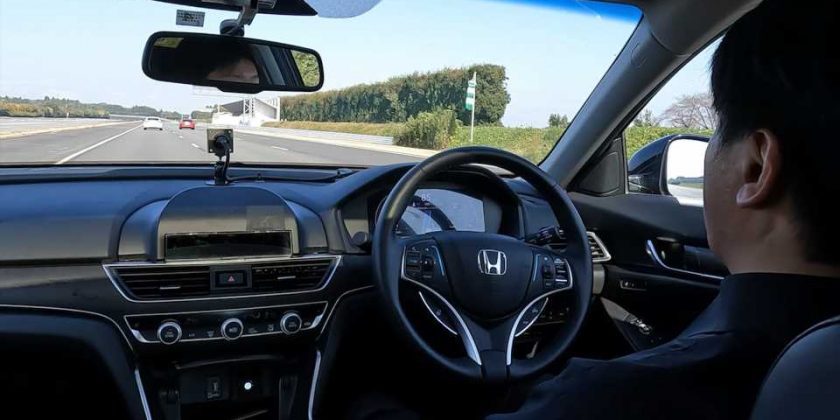The Honda Sensing active safety suite have been assisting Honda drivers in North America since 2014 with features such as lane-departure warning, lane-keep assist, adaptive cruise control, and automated emergency braking. Now, the Japanese brand looks to expand its driver assist systems by adding more features to the Honda Sensing Automated Driving Assistance Systems (ADAS). Enter Honda Sensing 360 and—for a taste of the future beyond—a version dubbed Sensing Elite that goes beyond hands-free interstate driving. Not only that, but Honda also has the goal of making this updated version of Honda Sensing 360 standard across all of its platforms by 2030.
While Honda feels it’s been successful to this point working toward the goal of reducing global traffic collision fatalities involving its four- and two-wheeled vehicles, further progress requires much more than just alerts and simple driver assists. Think semi-autonomous capabilities. And that extra capability on the car’s part requires more backup systems for tracking the driver’s alertness and, if needed, safely responding to a driver who either can’t or won’t take back control of the vehicle when prompted.
That’s why Honda has been hard at work to create the next generation of Honda Sensing (also known as AcuraWatch when installed in Acura products) to meet that important goal. While it’s been deployed in China since this year, starting in 2024, Honda will expand the capabilities of Honda Sensing 360 and also make these systems standard across its lineup by the end of the decade.
New Features of Honda Sensing 360
Advanced In Lane Driving with Hands-Off Function is one of Honda Sensing 360’s most impressive features. Though it stops short of fully autonomous capability (SAE Level 4), it is a solid Level 2-plus effort that will allow drivers to take their hands off the wheel when the system is running. Beyond typical adaptive cruise control and lane-keep functions (maintaining a set distance from cars ahead and steering to stay in its lane), this hands-free setup can adjust its speed for curves and even perform automated lane changes and passing. The vehicle will alert the driver when it’s going to perform such maneuvers, but won’t ask for their hands on the wheel.
There will be situations Honda Sensing 360 won’t be capable of navigating, and in those cases—as is required in Level 2 systems—it will alert the driver and attempt to hand control back to them. Should the driver not retake control for whatever reason (inattentiveness or a medical emergency), within a short period of time, the Honda Sensing 360 system will slow the vehicle to a complete stop all the while increasing the alerts to get the driver to respond. If the driver is still unable to answer, the vehicle will then flash its hazard lights and sound the horn in an effort to warn other vehicles around it that the driver and passengers are not responding and hopefully prevent a collision.
Even while still in motion, the system actively scans the vehicle’s surroundings and will, for example, steer the vehicle enough to avoid collisions with roadside objects or obstacles encroaching into your lane. This applies even in cases where the driver hasn’t responded to warnings or is simply driving carelessly. The system reduces the vehicle’s speed, gets the driver’s attention, and then assists with the steering to keep the vehicle in its lane while also avoiding the obstacle. Emergency Steering Support Technology helps drivers make manual emergency maneuvers by reducing speed and assisting in steering movement to avoid obstacles, too.
Honda Sensing 360’s Exit Warning feature kicks in when the vehicle is stationary and occupants move to exit the car, warning of incoming bicycles, motorcycles, or other cars approaching. A similar system was recently introduced by Lexus, and if you’ve ever tried wriggling out of your car on a busy city street, you’ll know what we’re on about here. For front occupants, there is an indicator on either the A-pillar or in the mirror to indicate that there is a vehicle coming. There is also an audible warning for everyone else trying to get out.
The Future of Honda Sensing Elite
Moving past 360, Honda also provided a preview of some new technologies it looks to add to its Honda Sensing Elite. This Level 3 automated system was already able to pilot itself down expressways and interstates, but Honda is looking to expand the system beyond those straighter roads to arterial roadways and entrance and exit ramps. This will allow Hondas to seamlessly merge on and off freeways and interstates without driver intervention. Honda also wants its Elite system to be capable of autonomously self-parking. Much of this will require new artificial intelligence (AI) technology from Honda that learns and can recognize complex situations like non-expressway driving, and handle them much like human drivers do. With the goal of reducing traffic fatalities in Honda products by half in 2030 only a few years away, this requires some acceleration of this highly complex level of automation. For now, Honda hasn’t committed to a delivery date for this AI-driven Honda Sensing Elite.
While the current version of Honda Sensing is standard on all new Hondas and Acuras in the U.S., the new version of Honda Sensing 360 (and AcuraWatch, we know we didn’t mention it much by name) with its hands-free technologies will start to become standard by 2024. The goal is to have all Honda models to have this new version as standard equipment by 2030.
Source: Read Full Article
